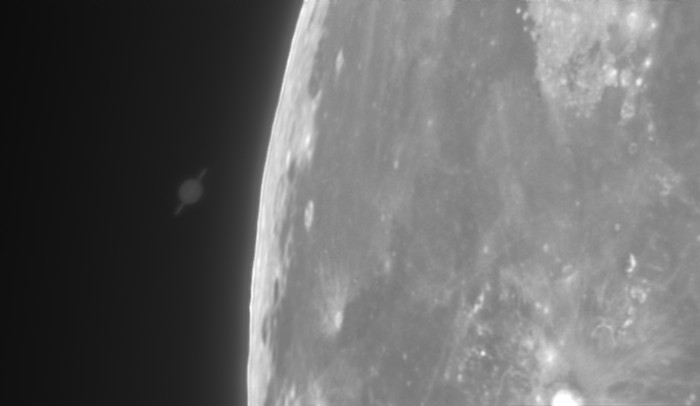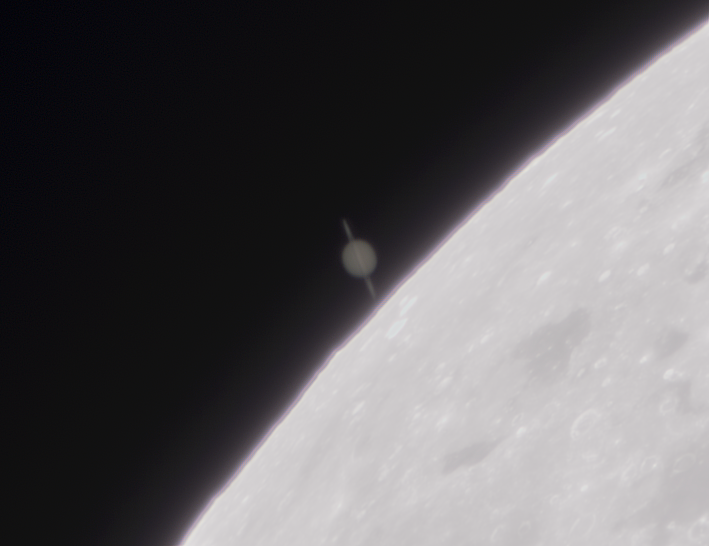Hello everyone. Im new to the forum space and I would like to ask a question. Yesterday (08/20) there was a lunar occultion with Saturn and the Moon. And i would like to know how I can process it so the Moon doesn't appear very bright and Saturn doesn't appear to dim. Thanks
|
You cannot like this item. Reason: "ANONYMOUS".
You cannot remove your like from this item.
Editing a post is only allowed within 24 hours after creating it.
You cannot Like this post because the topic is closed.
Copy the URL below to share a direct link to this post.
This post cannot be edited using the classic forums editor.
To edit this post, please enable the "New forums experience" in your settings.
I would make separate properly exposed stacks for the moon and Saturn and then composite them together in Photoshop, Gimp, Affinity Photo, whatever you are using. I even had to do that for the Jupiter/Saturn conjunction a few years back because the difference between the two was just to much to get the image I wanted.
|
You cannot like this item. Reason: "ANONYMOUS".
You cannot remove your like from this item.
Editing a post is only allowed within 24 hours after creating it.
You cannot Like this post because the topic is closed.
Copy the URL below to share a direct link to this post.
This post cannot be edited using the classic forums editor.
To edit this post, please enable the "New forums experience" in your settings.
Thanks for the help! I think i will do that, i really cant find another solution than making a composite
|
You cannot like this item. Reason: "ANONYMOUS".
You cannot remove your like from this item.
Editing a post is only allowed within 24 hours after creating it.
You cannot Like this post because the topic is closed.
Copy the URL below to share a direct link to this post.
This post cannot be edited using the classic forums editor.
To edit this post, please enable the "New forums experience" in your settings.
If no area is overexposed (as the Moon crossing would have been in the Moon's shadow if I recall right) or underexposed then it is possible to modulate the relative brightness using a non-linear transformation. To be more specific we would need to have an example and what are you using to create the final image (a movie, a single shot, a collection of single shots etc).
|
You cannot like this item. Reason: "ANONYMOUS".
You cannot remove your like from this item.
Editing a post is only allowed within 24 hours after creating it.
You cannot Like this post because the topic is closed.
Copy the URL below to share a direct link to this post.
This post cannot be edited using the classic forums editor.
To edit this post, please enable the "New forums experience" in your settings.
I searched for an exposure time and gain that would not blow out the Lunar surface, but still show Saturn. The stacked image below was treated with non-linear curves (like Andrea said) to improve visibility of the planet while keeping the lunar surface under control. In my opinion, you can get a more pleasing image by making a composite. It gives you the best contrast in each object.  |
You cannot like this item. Reason: "ANONYMOUS".
You cannot remove your like from this item.
Editing a post is only allowed within 24 hours after creating it.
You cannot Like this post because the topic is closed.
Copy the URL below to share a direct link to this post.
This post cannot be edited using the classic forums editor.
To edit this post, please enable the "New forums experience" in your settings.
andrea tasselli:
If no area is overexposed (as the Moon crossing would have been in the Moon's shadow if I recall right) or underexposed then it is possible to modulate the relative brightness using a non-linear transformation. To be more specific we would need to have an example and what are you using to create the final image (a movie, a single shot, a collection of single shots etc). I made a movie of the entire occultation process, after that I stacked the first 800 frames of the film.
|
You cannot like this item. Reason: "ANONYMOUS".
You cannot remove your like from this item.
Editing a post is only allowed within 24 hours after creating it.
You cannot Like this post because the topic is closed.
Copy the URL below to share a direct link to this post.
This post cannot be edited using the classic forums editor.
To edit this post, please enable the "New forums experience" in your settings.
Victor Van Puyenbroeck:
I searched for an exposure time and gain that would not blow out the Lunar surface, but still show Saturn. The stacked image below was treated with non-linear curves (like Andrea said) to improve visibility of the planet while keeping the lunar surface under control. In my opinion, you can get a more pleasing image by making a composite. It gives you the best contrast in each object.
 Totally. I did get a quite pleasing result but a composite is still a better choice  |
You cannot like this item. Reason: "ANONYMOUS".
You cannot remove your like from this item.
Editing a post is only allowed within 24 hours after creating it.
You cannot Like this post because the topic is closed.
Copy the URL below to share a direct link to this post.
This post cannot be edited using the classic forums editor.
To edit this post, please enable the "New forums experience" in your settings.




